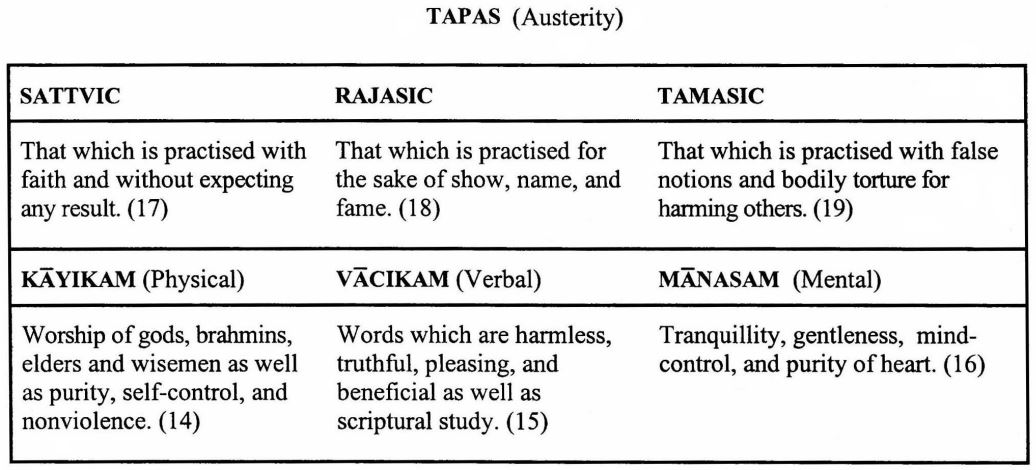Bhagavad Gita-Chapter 17 All Verses with Meaning and Audio
ये शास्त्रविधिमुत्सृज्य यजन्ते श्रद्धयान्विताः ।
तेषां निष्ठा तु का कृष्ण सत्त्वमाहो रजस्तमः ॥ १७-१॥
ye śāstravidhimutsṛjya yajante śraddhayānvitāḥ
teṣāṃ niṣṭhā tu kā kṛṣṇa sattvamāho rajastamaḥ 17-1
त्रिविधा भवति श्रद्धा देहिनां सा स्वभावजा ।
सात्त्विकी राजसी चैव तामसी चेति तां शृणु ॥ १७-२॥
trividhā bhavati śraddhā dehināṃ sā svabhāvajā
sāttvikī rājasī caiva tāmasī ceti tāṃ śṛṇu 17-2
श्रद्धामयोऽयं पुरुषो यो यच्छ्रद्धः स एव सः ॥ १७-३॥
śraddhāmayo’yaṃ puruṣo yo yacchraddhaḥ sa eva saḥ 17-3
प्रेतान्भूतगणांश्चान्ये यजन्ते तामसा जनाः ॥ १७-४॥
pretānbhūtagaṇāṃścānye yajante tāmasā janāḥ 17-4
दम्भाहङ्कारसंयुक्ताः कामरागबलान्विताः ॥ १७-५॥
dambhāhaṅkārasaṃyuktāḥ kāmarāgabalānvitāḥ 17-5
मां चैवान्तःशरीरस्थं तान्विद्ध्यासुरनिश्चयान् ॥ १७-६॥
māṃ caivāntaḥśarīrasthaṃ tānviddhyāsuraniścayān 17-6
यज्ञस्तपस्तथा दानं तेषां भेदमिमं शृणु ॥ १७-७॥
yajñastapastathā dānaṃ teṣāṃ bhedamimaṃ śṛṇu 17-7
रस्याः स्निग्धाः स्थिरा हृद्या आहाराः सात्त्विकप्रियाः ॥ १७-८॥
rasyāḥ snigdhāḥ sthirā hṛdyā āhārāḥ sāttvikapriyāḥ 17-8
आहारा राजसस्येष्टा दुःखशोकामयप्रदाः ॥ १७-९॥
āhārā rājasasyeṣṭā duḥkhaśokāmayapradāḥ 17-9
उच्छिष्टमपि चामेध्यं भोजनं तामसप्रियम् ॥ १७-१०॥
ucchiṣṭamapi cāmedhyaṃ bhojanaṃ tāmasapriyam 17-10
यष्टव्यमेवेति मनः समाधाय स सात्त्विकः ॥ १७-११॥
yaṣṭavyameveti manaḥ samādhāya sa sāttvikaḥ 17-11
इज्यते भरतश्रेष्ठ तं यज्ञं विद्धि राजसम् ॥ १७-१२॥
ijyate bharataśreṣṭha taṃ yajñaṃ viddhi rājasam 17-12
श्रद्धाविरहितं यज्ञं तामसं परिचक्षते ॥ १७-१३॥
śraddhāvirahitaṃ yajñaṃ tāmasaṃ paricakṣate 17-13
ब्रह्मचर्यमहिंसा च शारीरं तप उच्यते ॥ १७-१४॥
brahmacaryamahiṃsā ca śārīraṃ tapa ucyate 17-14
स्वाध्यायाभ्यसनं चैव वाङ्मयं तप उच्यते ॥ १७-१५॥
svādhyāyābhyasanaṃ caiva vāṅmayaṃ tapa ucyate 17-15
भावसंशुद्धिरित्येतत्तपो मानसमुच्यते ॥ १७-१६॥
bhāvasaṃśuddhirityetat tapomānasamucyate 17-16
अफलाकाङ्क्षिभिर्युक्तैः सात्त्विकं परिचक्षते ॥ १७-१७॥
aphalākāṅkṣibhiryuktaiḥ sāttvikaṃ paricakṣate 17-17
क्रियते तदिह प्रोक्तं राजसं चलमध्रुवम् ॥ १७-१८॥
kriyate tadiha proktaṃ rājasaṃ calamadhruvam 17-18
परस्योत्सादनार्थं वा तत्तामसमुदाहृतम् ॥ १७-१९॥
parasyotsādanārthaṃ vā tattāmasamudāhṛtam 17-19
देशे काले च पात्रे च तद्दानं सात्त्विकं स्मृतम् ॥ १७-२०॥
deśe kāle ca pātre ca taddānaṃ sāttvikaṃ smṛtam 17-20
दीयते च परिक्लिष्टं तद्दानं राजसं स्मृतम् ॥ १७-२१॥
dīyate ca parikliṣṭaṃ taddānaṃ rājasaṃ smṛtam 17-21
असत्कृतमवज्ञातं तत्तामसमुदाहृतम् ॥ १७-२२॥
asatkṛtamavajñātaṃ tattāmasamudāhṛtam 17-22
ब्राह्मणास्तेन वेदाश्च यज्ञाश्च विहिताः पुरा ॥ १७-२३॥
brāhmaṇāstena vedāśca yajñāśca vihitāḥ purā 17-23
प्रवर्तन्ते विधानोक्ताः सततं ब्रह्मवादिनाम् ॥ १७-२४॥
pravartante vidhānoktāḥ satataṃ brahmavādinām 17-24
दानक्रियाश्च विविधाः क्रियन्ते मोक्षकाङ्क्षिभिः ॥ १७-२५॥
dānakriyāśca vividhāḥ kriyante mokṣakāṅkṣibhiḥ 17-25
प्रशस्ते कर्मणि तथा सच्छब्दः पार्थ युज्यते ॥ १७-२६॥
praśaste karmaṇi tathā sacchabdaḥ pārtha yujyate 17-26
कर्म चैव तदर्थीयं सदित्येवाभिधीयते ॥ १७-२७॥
karma caiva tadarthīyaṃ sadityevābhidhīyate 17-27
असदित्युच्यते पार्थ न च तत्प्रेत्य नो इह ॥ १७-२८॥
ॐ तत्सदिति श्रीमद्भगवद्गीतासूपनिषत्सु
ब्रह्मविद्यायां योगशास्त्रे श्रीकृष्णार्जुनसंवादे
श्रद्धात्रयविभागयोगो नाम सप्तदशोऽध्यायः ॥ १७॥
asadityucyate pārtha na ca tatpretya no iha 17-28
oṃ tatsaditi śrīmadbhagavadgītāsūpaniṣatsu
brahmavidyāyāṃ yogaśāstre śrīkṛṣṇārjunasaṃvāde
śraddhātrayavibhāgayogo nāma saptadaśo’dhyāyaḥ 28

Description
Bhagavad Gita Chapter 17 Summary
Sraddhā-Traya-Vibhāga-Yoga – The Yoga of Differentiating Threefold Faith
In this chapter, the Lord shows how the concept of “guna” that was detailed in the 14th chapter applies to faith, worship, food, sacrifices/rituals, austerities and charity. The Lord explains that these common activities can each be categorized as sattvic, rajasic or tamasic depending on the manner in which they are conducted. Our goal is to engage in only the sattvic varieties since that alone is conducive to spiritual development. Below are the main themes of Chapter 17:
Verses 1 – 6
Arjuna’s question and three types of śraddhā
Verses 7
Kṛṣṇa introduces new topics
Verses 8 – 10
Three types of food
Verses 11 – 13
Three types of yajña
Verses 14 – 16
Three types of tapas (based on instrument)
Verses 17 – 19
Three types of tapas (based on guṇa)
Verses 20 – 22
Three types of charity
Verses 23 – 28
Significance of “om tat sat” and conclusion
Gita Chapter 17 – Commentary by Swami Paramarthananda
Background
In the previous chapter, Bhagavān said that śāstra is the pramāṇa in determining what is right and wrong and that one should act according to what śāstra says. Based on this, Arjuna raises a question here — “To what category does a person belong if he worships with faith without scriptural knowledge – sattvic, rajasic, or tamasic?” (1)
Krishna answers that he may belong to any category according to his temperament. An ignorant person’s faith will depend on his nature since he has no scriptural knowledge to guide. (By observing various types of worship done by others, he develops his faith according to his character. On the other hand, a person who goes by the scriptural teaching will invariably have sattvic faith) (2, 3).
Krishna differentiates three types of faith based upon the object of worship (4). Even the nature of worship varies according to faith. People of tamasic faith take to severe practices involving torture of the body etc. (5, 6).
Having answered Arjuna’s question, Krishna discusses a few more topics namely food, yajña, tapas and charity, differentiating them into three types based on the guṇas (7 to 22). (Refer to the chart below.) [A seeker has to choose the sattvic type i.e. daivī-sampat and avoid rajasic and tamasic types i.e. āsurī-sampat.]
Bhagavān concludes the teaching mentioning the significance of the mantra “Om tat sat”. This originated from Brahmā’s mouth in the beginning of creation, and has been traditionally chanted during scriptural activities like yajña, tapas and dāna. The word ‘sat’ has many meanings like existence, goodness, good action, steadfastness and an action as an offering to the Lord (23 to 27). [In essence the utterance of this mantra will sanctify scriptural actions and make them sattvic.]
In the last verse, Krishna emphasizes the importance of śraddhā (faith). Without faith all scriptural activities become asat, i.e. fruitless (28).
Gita 17th Chapter – Main Points
Arjuna’s question and three types of śraddhā: 1 to 6
Krishna introduces new topics: 7
Three types of food: 8 to 10
Three types of yajña: 11 to 13
Three types of tapas (based on instrument): 14 to 16
Three types of tapas (based on guṇa): 17 to 19
Three types of charity: 20 to 22
Significance of “om tat sat” and conclusion: 23 to 28
Since Śraddhā is highlighted both in the beginning and in the end, this chapter is called Śraddhātraya vibhāga yoga.

Krishna divides tapas on the basis of the guṇās and also on the basis of the instrument as given below:

Other Bhagavad Gita Shlokams
Bhagavad Gita
The Bhagavad Gita, or the Song of the Lord, is a dialogue between Krishna, an incarnation of Vishnu, and his friend and disciple, Arjuna. Composed of 701 Shlokas arranged in 18 chapters, the Gita is one of the best-known philosophical texts of…
Bhagavad Gita-Chapter 01 All Verses with Meaning and Audio
Bhagavad Gita Chapter 1 All Verses for easy chanting along with Audio and Meaning. Lyrics In English, Sanskrit, Hindi, Telugu, Tamil, Gujarati, Bengali and many more languages.
Bhagavad Gita-Chapter 02 All Verses with Meaning and Audio
Bhagavad Gita Chapter 2 All Verses for easy chanting along with Audio and Meaning. Lyrics In English, Sanskrit, Hindi, Telugu, Tamil, Gujarati, Bengali and many more languages.
Bhagavad Gita-Chapter 03 All Verses with Meaning and Audio
Bhagavad Gita Chapter 3 All Verses for easy chanting along with Audio and Meaning. Lyrics In English, Sanskrit, Hindi, Telugu, Tamil, Gujarati, Bengali and many more languages.
Bhagavad Gita-Chapter 04 All Verses with Meaning and Audio
Bhagavad Gita Chapter 4 All Verses for easy chanting along with Audio and Meaning. Lyrics In English, Sanskrit, Hindi, Telugu, Tamil, Gujarati, Bengali and many more languages.
Bhagavad Gita-Chapter 05 All Verses with Meaning and Audio
Bhagavad Gita Chapter 5 All Verses for easy chanting along with Audio and Meaning. Lyrics In English, Sanskrit, Hindi, Telugu, Tamil, Gujarati, Bengali and many more languages.
Bhagavad Gita-Chapter 06 All Verses with Meaning and Audio
Bhagavad Gita Chapter 6 All Verses for easy chanting along with Audio and Meaning. Lyrics In English, Sanskrit, Hindi, Telugu, Tamil, Gujarati, Bengali and many more languages.
Bhagavad Gita-Chapter 07 All Verses with Meaning and Audio
Bhagavad Gita Chapter 7 All Verses for easy chanting along with Audio and Meaning. Lyrics In English, Sanskrit, Hindi, Telugu, Tamil, Gujarati, Bengali and many more languages.
Bhagavad Gita-Chapter 08 All Verses with Meaning and Audio
Bhagavad Gita Chapter 8 All Verses for easy chanting along with Audio and Meaning. Lyrics In English, Sanskrit, Hindi, Telugu, Tamil, Gujarati, Bengali and many more languages.
Bhagavad Gita-Chapter 09 All Verses with Meaning and Audio
Bhagavad Gita Chapter 9 All Verses for easy chanting along with Audio and Meaning. Lyrics In English, Sanskrit, Hindi, Telugu, Tamil, Gujarati, Bengali and many more languages.
Bhagavad Gita-Chapter 10 All Verses with Meaning and Audio
Bhagavad Gita Chapter 10 All Verses for easy chanting along with Audio and Meaning. Lyrics In English, Sanskrit, Hindi, Telugu, Tamil, Gujarati, Bengali and many more languages.
Bhagavad Gita-Chapter 11 All Verses with Meaning and Audio
Bhagavad Gita Chapter 11 All Verses for easy chanting along with Audio and Meaning. Lyrics In English, Sanskrit, Hindi, Telugu, Tamil, Gujarati, Bengali and many more languages.
Bhagavad Gita-Chapter 12 All Verses with Meaning and Audio
Bhagavad Gita Chapter 12 All Verses for easy chanting along with Audio and Meaning. Lyrics In English, Sanskrit, Hindi, Telugu, Tamil, Gujarati, Bengali and many more languages.
Bhagavad Gita-Chapter 13 All Verses with Meaning and Audio
Bhagavad Gita Chapter 13 All Verses for easy chanting along with Audio and Meaning. Lyrics In English, Sanskrit, Hindi, Telugu, Tamil, Gujarati, Bengali and many more languages.
Bhagavad Gita-Chapter 14 All Verses with Meaning and Audio
Bhagavad Gita Chapter 14 All Verses for easy chanting along with Audio and Meaning. Lyrics In English, Sanskrit, Hindi, Telugu, Tamil, Gujarati, Bengali and many more languages.
Bhagavad Gita-Chapter 15 All Verses with Meaning and Audio
Bhagavad Gita Chapter 15 All Verses for easy chanting along with Audio and Meaning. Lyrics In English, Sanskrit, Hindi, Telugu, Tamil, Gujarati, Bengali and many more languages.
Bhagavad Gita-Chapter 16 All Verses with Meaning and Audio
Bhagavad Gita Chapter 16 All Verses for easy chanting along with Audio and Meaning. Lyrics In English, Sanskrit, Hindi, Telugu, Tamil, Gujarati, Bengali and many more languages.
Bhagavad Gita-Chapter 18 All Verses with Meaning and Audio
Bhagavad Gita Chapter 18 All Verses for easy chanting along with Audio and Meaning. Lyrics In English, Sanskrit, Hindi, Telugu, Tamil, Gujarati, Bengali and many more languages.
Gita Dhyanam
The Gītā Dhyānam, also called the Gītā Dhyāna or the Dhyāna Ślokas associated with the Gītā, is a 9-verse Sanskrit poem that has often been attached to the Bhagavad Gita, one of the most important scr
Bhagavad Gita-Chapter 17 All Verses with Meaning and Audio – Bhagavad Gita – Bhagavad Gita Chapter 17 All Verses Easy Chanting with Audio and Meaning, Lyrics




